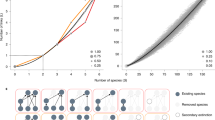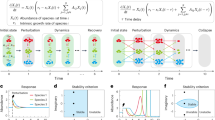Abstract
Ecosystems and their embedded ecological communities are almost always by definition collections of oscillating populations. This is apparent given the qualitative reality that oscillations emerge from consumer-resource interactions, which are the elementary building blocks for ecological communities. It is also likely always the case that oscillatory consumer-resource pairs will be connected to one another via trophic cross-feeding with shared resources or via competitive interactions among resources. Thus, one approach to understanding the dynamics of communities conceptualizes them as collections of oscillators coupled in various arrangements. Here we look to the pioneering work of Kuramoto on coupled oscillators and ask to what extent can his insights and approaches be translated to ecological systems. We explore the four ecologically significant coupling arrangements of the simple case of three oscillator systems with both the Kuramoto model and with the classical Lotka-Volterra equations. Our results show that the six-dimensional Lotka-Volterra systems behave strikingly similarly to that of the corresponding Kuramoto systems across all coupling combinations. This qualitative similarity in the results between these two approaches suggests that a vast literature on coupled oscillators may be relevant in furthering our understanding of ecosystem and community organization.



Similar content being viewed by others
References
Benincà E, Jöhnk KD, Heerkloss R, Huisman J (2009) Coupled predator–prey oscillations in a chaotic food web. Ecol Lett 12(12):1367–1378
Blasius B, Huppert A, Stone L (1999) Complex dynamics and phase synchronization in spatially extended ecological systems. Nature 399(6734):354–359
Blasius B, Rudolf L, Weithoff G, Gaedke U, Fussmann GF (2020) Long-term cyclic persistence in an experimental predator–prey system. Nature 577(7789):226–230
DeAngelis DL, Waterhouse JC (1987) Equilibrium and nonequilibrium concepts in ecological models. Ecological monographs 57(1):1–21
Earn DJ, Levin SA, Rohani P (2000) Coherence and conservation. Science 290(5495):1360–1364
Earn DJ, Rohani P, Grenfell BT (1998) Persistence, chaos and synchrony in ecology and epidemiology. Proceedings of the Royal Society of London. Series B: Bio Sci 265(1390):7–10
Fukuyama T, Okugawa M (2017) Dynamic characterization of coupled nonlinear oscillators caused by the instability of ionization waves. Phys Plasmas 24(3):032302
Holling CS (1959) Some characteristics of simple types of predation and parasitism. Can Entomol 91(7):385–398
Huffaker C (1958) Experimental studies on predation: dispersion factors and predator-prey oscillations. Hilgardia 27(14):343–383
Huisman J, Weissing FJ (2001) Biological conditions for oscillations and chaos generated by multispecies competition. Ecology 82(10):2682–2695
Hutchinson GE (1961) The paradox of the plankton. Am Nat 95(882):137–145
Kaemingk MA, Chizinski CJ, Hurley KL, Pope KL (2018) Synchrony—an emergent property of recreational fisheries. J Appl Ecol 55(6):2986–2996
Koelle K, Vandermeer J (2005) Dispersal-induced desynchronization: from metapopulations to metacommunities. Ecol Lett 8(2):167–175
Kotwal T, Jiang X, Abrams DM (2017) Connecting the Kuramoto model and the chimera state. Phys Rev Lett 119(26):264101
Kuramoto Y (1975) Self-entrainment of a population of coupled non-linear oscillators. In International symposium on mathematical problems in theoretical physics Springer Berlin Heidelberg (pp. 420–422)
Kuramoto Y (1984) Cooperative dynamics of oscillator communitya study based on lattice of rings. Progress of Theoretical Physics Supplement 79:223–240
Laing CR (2009) The dynamics of chimera states in heterogeneous Kuramoto networks. Physica D 238(16):1569–1588
Laing CR (2017) Phase oscillator network models of brain dynamics. Computational models of brain and behavior (pp. 505–517)
Lawton JH (1999) Are there general laws in ecology? Oikos (pp. 177–192)
Liebhold A, Koenig WD, Bjørnstad ON (2004) Spatial synchrony in population dynamics. Annu Rev Ecol Evol Syst 35:467–490
Lotka AJ (1926) Elements of physical biology. Sci Prog Twent Century (1919-1933) 21(82): 341-343.
Matter SF (2001) Synchrony, extinction, and dynamics of spatially segregated, heterogeneous populations. Ecol Model 141(1–3):217–226
Morozov A, Abbott K, Cuddington K, Francis T, Gellner G, Hastings A, Lai YC, Petrovskii S, Scranton K, Zeeman ML (2019) Long transients in ecology: theory and applications. Phys of Life Rev
Norton M, Hunter I, Moustaka M, Crisholm A, Hagan M, Fahmy Y, Fraden S (2018) Multistable dynamical network of diffusively coupled chemical oscillators. Bulletin of the American Physical Society 63
Platt T, Denman KL (1975) Spectral analysis in ecology. Annu Rev Ecol Syst 6(1):189–210
Reuman DC, Costantino RF, Desharnais RA, Cohen JA (2008) Colour of environmental noise affects the nonlinear dynamics of cycling, stage-structured populations. Ecol Lett 11:820–830. https://doi.org/10.1111/j.1461-0248.2008.01194.x
Strogatz SH (2000) From Kuramoto to Crawford: exploring the onset of synchronization in populations of coupled oscillators. Physica D 143(1–4):1–20
Vandermeer J (1993) Loose coupling of predator-prey cycles: entrainment, chaos, and intermittency in the classic MacArthur consumer-resource equations. Am Nat 141(5):687–716
Vandermeer J (1994) The qualitative behavior of coupled predator-prey oscillations as deduced from simple circle maps. Ecol Model 73(1–2):135–148
Vandermeer J (2004) Coupled oscillations in food webs: balancing competition and mutualism in simple ecological models. Am Nat 163(6):857–867
Vandermeer J (2006) Oscillating populations and biodiversity maintenance. Bioscience 56(12):967–975
Vandermeer J, Armbrecht I, Mora de la A et al (2019) The community ecology of herbivore regulation in an agroecosystem: lessons from complex systems. Bioscience 69(12):974–996
Vasseur DA, Gaedke U (2007) Spectral analysis unmasks synchronous and compensatory dynamics in plankton communities. Ecology 88(8):2058–2071
Vellend M (2010) Conceptual synthesis in community ecology. Q Rev Biol 85(2):183–206
Volterra V (1927) Variazioni e fluttuazioni del numero d’individui in specie animali conviventi. C. Ferrari
Vasseur D, Fox JW (2007) Environmental fluctuations can stabilize food web dynamics by increasing synchrony. Ecol Lett 10:1066–1074
Acknowledgments
The students in the “Complex Systems in Ecology” course in Fall 2019 at University of Michigan participated in stimulating discussions related to the ideas presented here. Chatura Vaidya and Kristel Sanchez provided useful feedback on an earlier draft of the manuscript. Several examples from Ferdinand LaMothe and Oscar Peterson provided intuition into the dynamics of coupled oscillators that was useful in the development of this manuscript.
Funding
Work supported by NSF grant number DEB—1853261.
Author information
Authors and Affiliations
Corresponding author
Ethics declarations
Conflict of interest
The authors declare that they have no conflicts of interest.
Appendix
Appendix
\(\frac{1}{2}\sum{\varvec{\Gamma}}=1\) for the Lotka-Volterra system of ordinary differential equations has C1 with trophic-coupling on R2 and R3, C2 with trophic-coupling on R1, C3 with trophic-coupling on R1, and R2 and R3 resource coupled. Initial conditions for Fig. 2 are as follows: \({R}_{1}\) = 0.05, \({R}_{2}\) = 0.10, \({R}_{3}\) = 0.35, \({C}_{1}\) = 0.06, \({C}_{2}\) = 0.11, and \({C}_{3}\) = 0.36.
for \(\frac{1}{2}\sum\Gamma =-1\) for the Lotka-Volterra system of ordinary differential equations has C1 with trophic-coupling on R2; C2 with trophic-coupling on R1, R2, and R3 with resource-coupling; and R1 and R3 with resource-coupling. Initial conditions for Fig. 2 are as follows: \({R}_{1}\) = 0.60, \({R}_{2}\) = 0.30, \({R}_{3}\)= 0.10, \({C}_{1}\) = 0.61, \({C}_{2}\) = 0.31, and \({C}_{3}\) = 0.11.
for \(\frac{1}{2}\sum{\varvec{\Gamma}}=-3\) has pairwise resource-coupling between all resources and no trophic-coupling. Initial conditions for Fig. 2 are as follows: \({R}_{1}\) = 0.50, \({R}_{2}\) = 0.55, \({R}_{3}\) = 0.45, \({C}_{1}\) = 0.51, \({C}_{2}\) = 0.56, and \({C}_{3}\) = 0.46.
for \(\frac{1}{2}\sum\Gamma =3\) has pairwise trophic-coupling between all consumers and resources and no resource-coupling. Initial conditions for Fig. 2 are follows: \({R}_{1}\) = 0.10, \({R}_{2}\) = 0.20, \({R}_{3}\) = 0.45, \({C}_{1}\) = 0.11, \({C}_{2}\) = 0.21, and \({C}_{3}\)= 0.46.
Rights and permissions
About this article
Cite this article
Hajian-Forooshani, Z., Vandermeer, J. Viewing communities as coupled oscillators: elementary forms from Lotka and Volterra to Kuramoto. Theor Ecol 14, 247–254 (2021). https://doi.org/10.1007/s12080-020-00493-4
Received:
Accepted:
Published:
Issue Date:
DOI: https://doi.org/10.1007/s12080-020-00493-4




